-
Posts
6,860 -
Joined
-
Last visited
Content Type
Profiles
Forums
Gallery
Events
Articles
Posts posted by gxseries
-
-
Hahaha this is hilarious. Made my day.
Makes me wonder what they use the quarters for. Potential ammos against humans who try to annoy them???
-
Very nice coins Vasil. I like them!
Actelios - I bought it about last year (I think) when I realize prices of the 1922 ruble kept on going up and up. That was more than what I wanted for - probably more than 200 dollars back then but when I checked the prices recently, it's edging closer to 250 - 400 dollars

-
I like it Eugene. I'll start to hunt them down.
 I've got reasons to doubt the 1837 2 kopek coin as well. Wondered what the edge looked like.
I've got reasons to doubt the 1837 2 kopek coin as well. Wondered what the edge looked like.Did the article mention about Iran using Russian 2 kopek coins (1810 - 1830) as planchets? I've been hunting for one but they are rather scarce.
There was also a 1742 (?) grivennik overstruck over a 1741 ruble if I am not mistaken. I forgot to save the pictures and I can't find the thread

-
Issued around 1660s to late 1680s, a set of coins from various provinces had mintmarks that were issued in both Chinese and Manchu scripts. A lot of coins prior to this had mintmarks that were issued in Manchu scripts only. This particular series is very interesting as well as highly collectable as they can be arranged to form a poem. I'm not too sure if this was ever a commemorative set but this is really neat. Superstition wise, appearently it is said that it repels evil forces. We'll see about that...
Difficulty wise, they can be very hard to find in particular coins from Taiwan, Guangdong (Kwangtung), Hunan (Honan), Yunnan and so forth. There's interesting stories from some provinces of why they are hard to find, choice of metal, weight differences, varieties and so forth. Even in this lot itself, some coins are as small as 22mm to 26mm! Some are clearly cast in high quality copper due to the price of zinc being too expensive, some mints cutting corners in particular Henan (Honan). Weight difference - a coin from Henan (Honan) at 2.58g to the heaviest from Jiangxi (Kiangsi) at 5.06g. Henan (Honan) coins were supposedly forbidden to circulate as it was severely underweight. Most coins are around the 3.5 to 4g mark.
I find the Taiwan coin to be very interesting as well as difficult to find. Leaving politics aside, this is one of the few coins that Taiwan issued under mainland China.
More information can found here:
http://www.sportstune.com/chinese/coins/kanghsi/kanghsipoem.html
http://ykleungn.tripod.com/kanghsia.htm

-
Finding a coin from this era in strong UNC / aUNC condition is really difficult, in particular the smaller denomination 1 fun.
I am really stoked to obtain one in raw condition like this.
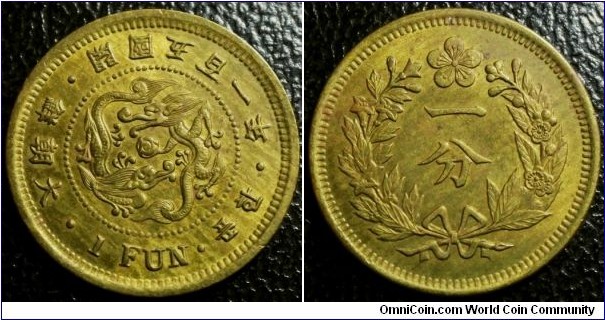
Unlike the larger denomination 5 fun, this coin is more yellow than red as it has aluminum in it. Only minted for four years, it seems to be a lot less common than 5 fun in any condition. UNC condition just makes it a lot more desirable.
Here's an example of 5 fun
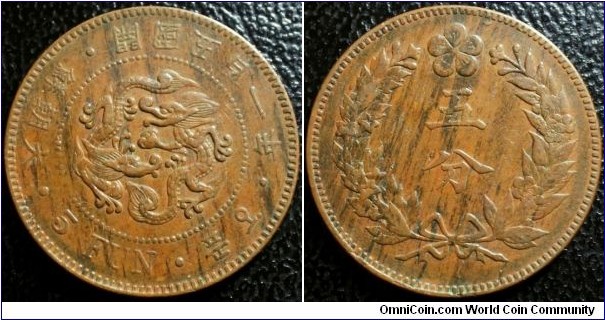
Bear in mind that a lot of these 5 fun coins were shipped off to China to be overstruck as 10 cash (most likely by private mints / fraud entrepreneurs). Even so, I reckon for every 1 fun coin out there, there's at least 10 of 5 fun coins. It's a "fun" collection.

-
Thanks everyone. Yes, appearently these were made back then.
I'm not sure if they were related to the rupee in one way or the other ccg. I don't think so but I could be wrong.
-
Normally I detest counterfeits with passion but this one stumped me with good reason.
This coin is supposedly from Guangdong Province dated 1920. An original coin would look like this and weighs around 5.3 grams.
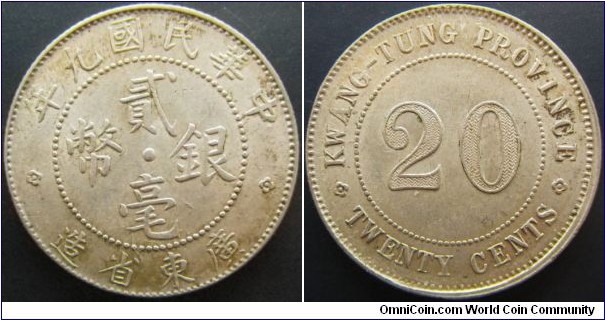
This is the supposedly contemporary counterfeit
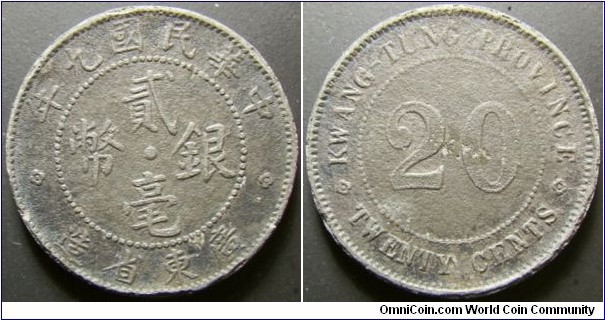
Could have passed on as a terribly oxidized silver that's banged up. Details look surprising good with reeded edge and I think this is either struck or cast in lead zinc alloy. You can write with this coin, i.e. if you rub the coin on a paper, you can write on it although it's not clear. Not too sure if this metal is right as it weights at a mere 4.41 grams. Maybe you can help me work out what the possible alloy is?
You normally see a lot of Chinese counterfeits that's struck in cheap iron / nickel alloy and they normally target crown size coins. I guess this is a counterfeit that was produced in the early days.
-
Why make life so difficult when prices are quoted in ounces?
 Divide and then mutiply - they cancel each other out.
Divide and then mutiply - they cancel each other out. -
Thought I might as well start a thread about cameras that you use to capture awesome coin photos. I've been using this camera for probably a couple of years.
I do own a DSLR camera but I am not a big fan of it due to it's weight plus it takes a fair bit of effort to set it up. You'll also need dedicated lens to take close up photos. At the same time, I'll like to show that you don't need an expensive camera to take good photos.
I've been using a few different cameras and the most recent is Pentax Optio W90. The one before is Ricoh. Don't really quite remember what I had before that - probably a Panasonic lumix which I struggled to take decent macro photo.
I've been clocking up to close to 4000 photos on the Pentax camera and I've got good reason to like it. It's a 12.1 mp camera and it's got a super macro which focuses it down to 1cm. I also like how the lens is integrated with the camera - if you live in a dusty enviroment, it can cause a bit of a grief. I had a camera where the lens was jammed due to dust and it was a write off.
It is dust proof and shock proof but that doesn't mean that you go and bash it up... water proof as well but I haven't tried it out yet.
I also like the read / write time - it's fast enough for what I do and this is taking multiples of photos before I make up my mind.
You may want to read this review here: http://www.imaging-resource.com/PRODS/OW90/OW90A.HTM
Personally I find it hard to beat the price of around 300 dollars when it was first out. It was a present from my dad as he knows that I take a lot of photos. Appearently you can get it around 150 dollars or a lot less if you are willing to go second hand.
What camera do you use? -
I like it!
This coin I reckon is the best Russian 1 kopek over Swedish 1 ore coin
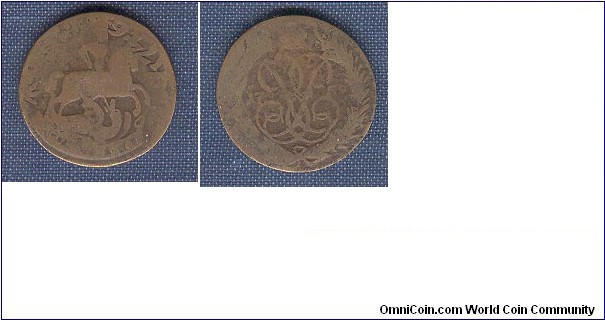
This is not my coin - it's mawett. You can see his collection over at omnicoin. Very very impressive.
-
I've been trying to locate 4 more coins of this series to complete it. Couple of these should be easy but I've been lazy. The smaller denomination of 1921 coins are difficult for some reason - probably low mintage from the start. 1922 ruble was hard to obtain in a reasonable price. I'm definitely not considering the 1923 chervonets...
http://gxseries.com/dump/russia_1921_23_rsfsr1_small.jpg
http://gxseries.com/dump/russia_1921_23_rsfsr2_small.jpg
I really like the toned coins.
Show off your awesome RSFSR coins!
-
Bought a couple of these as they were on offer at a really cheap price. I actually only wanted one but after seeing they were very different (and they were a bargain), I decided to get them both. (the joys of varieties)
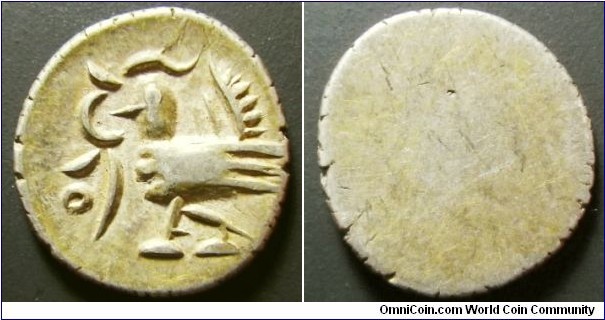
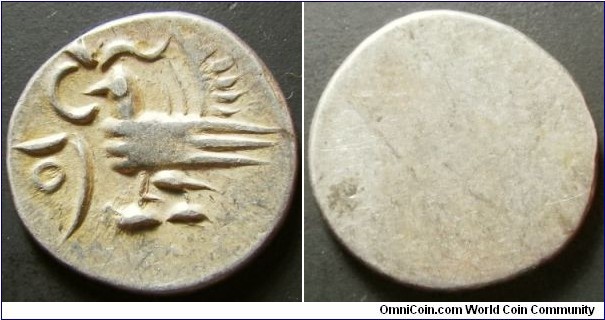
Denomination: 1/8 tical. This is a uniface coin.
Looked it up on the internet and there's just so many varieties of this particular type of coin. Maybe you have one of this funky coin?
-
I'm sure Uzdenikov has written an article about overstrikes a while ago. Unfortunately as my Russian is just too rusty, I don't understand much of it other than "ne znayu" or "chto eta".
Here's a couple of pages from his book
http://gxseries.com/dump/pg095.jpg
http://gxseries.com/dump/pg096.jpg
Pretty sad to buy articles that you can't even read but hope some day down the road you'll be able to understand it somehow.

I actually quite enjoyed it although it could use a bit more editing. It's good to see illustrations in color.
I did learn a lot from Uzdenikov's bilingual book 2nd edition and this is still the bible for me. I've also learned a fair bit from this forum as well over the many years.
I just only realized that you live in Melbourne - what a shame. If I was any closer, I think we could have looked at each other's collection and have a long chat.
-
You can't blame one-kuna - he was dying to know who the awesome writer is. :nod:
I'll be honest - I thought I saw a suspected 1802 2 kopek overstruck over an earlier type but I could be wrong. It has been a few years since I last checked it - I can't fully understand it for crying out loud
 There's a few illustration in the K.M. Temiraev book. I've only got the first edition - not sure what the second edition is like.
There's a few illustration in the K.M. Temiraev book. I've only got the first edition - not sure what the second edition is like. -
Think I've mentioned a while ago that I have an entire set of Soviet ruble coins (non commemorative) as well as noting that these coins are more difficult to complete compared to the Soviet commemorative coins. You could be in for a surprise to find some of the years are just too difficult to find. I also do have the earlier Soviet ruble silver coins (1921, 1922 and 1924) as well as all the other commemorative ruble coins. Only exception is the 1958 and all other pattern coins which I most likely will not see them in my life time.
The unfortunate side of photoshopping is that it takes too long for me to compile them into an album like this otherwise I would have a lot more to show.
Nevertheless, please enjoy the picture.
http://gxseries.com/numis/rus_new_type/russia_1ruble_61_pg1_small.jpg
Also please feel free to show some of the ruble coins (non commemorative).
-
Won this recently - a really strong and clear overstruck coin from Brazil with good details of the underhost. Only thing that's detracting is the hole but otherwise coins in conditions like this can be very very pricy.I reckon it's easily in XF condition. I also like the light toning around the legend.
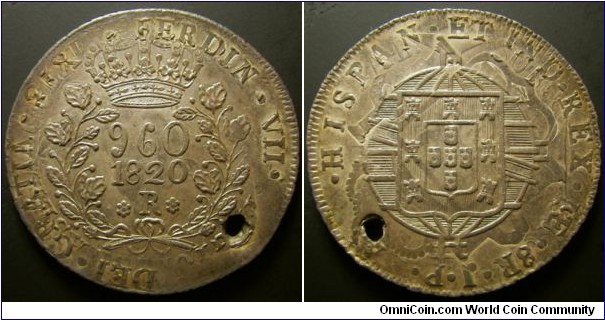
The original host coin is clearly identified as a 1813 8 reales. Only thing I didn't quite get is identifying the origins of the 8 reales. Appearently you can identify them by mintmaster marks but I don't specialize in South American coinage. The seller has already identified it as a Lima coin which i took it for granted.
From what I understand, Brazil has a history of overstriking and counterstamping coins in particular the Spanish / South American 8 reales. I don't quite understand the various denomination that was released in that particular era and would like to know more.
-
I like it. Did you publish the article? Bit unfortunate that my Russian is very very rusty - will have to take time to read and understand. Would love to understand every single bit of it.
That said, is there anything with regards to Swedish 1 ore used as planchets to be overstruck as 1 kopek 1757 - 1762? Also is there any mention about 1802 2 kopek that used coins from earlier era as planchets? I know it sounds ridicious but I've seen a couple of images that seem to suggest there could be such a possibility.
-
Uzbekistan is a rather interesting country if you are keen to collect coins from. You might have seen some news recently regarding the most worthless circulating coin issed by Uzbekistan in 1994 1 tiyin. Not too sure what it is worth but I really doubt if it's still circulating. 1 som at today's exchange rate is worth only 0.000469550 USD (from xe.com)
The first series issued in 1994 has a lot of varieties - all denomination has at least one different variety including coins issued by Pobjoy mint. Leaving that aside, little is known about Uzbekistan's national mint. Appearently it was setup in 1992 (more to follow about this) but as of why no coins were struck in the early days and Pobjoy mint was contracted to struck coins in 1994, there's a lot of questions to be asked. I've also tracked down the official website of the mint (took me a good couple of years) and it's here: http://davlat-belgisi.uz/index.php?lang=en
Note - almost all commemorative silver coins issued by Uzbekistan are considered to be relatively scarce as they are just too difficult to find especially the earlier issues.
I've recently obtained an interesting mint token and this seems to be the offical set from the Davlat Belgisi. In tatters though - haven't seen another one around. Davlat Belgisi owns the paper mill and printing company - probably similar to the Goznak in Russia.
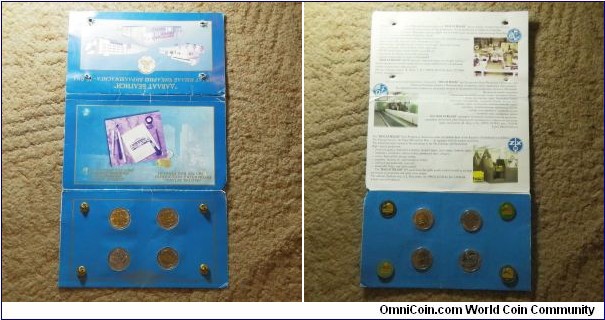
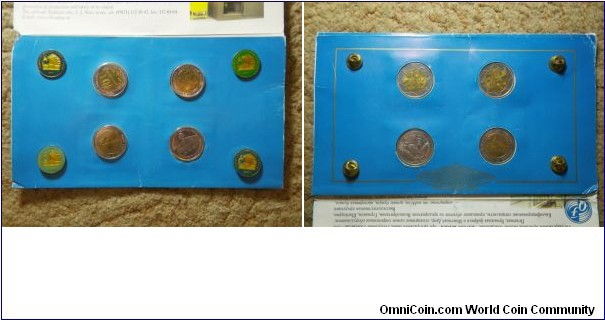
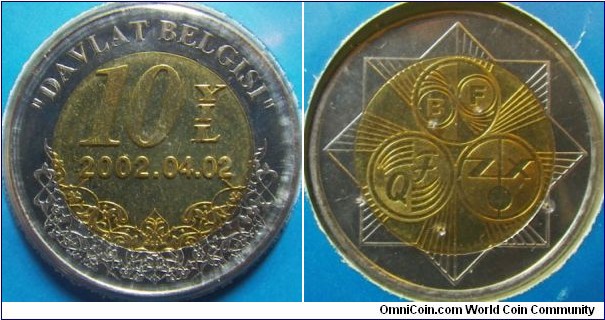
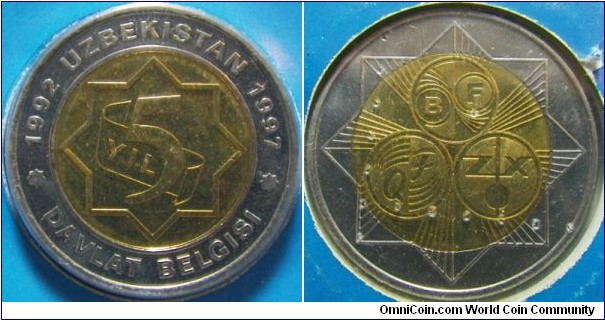
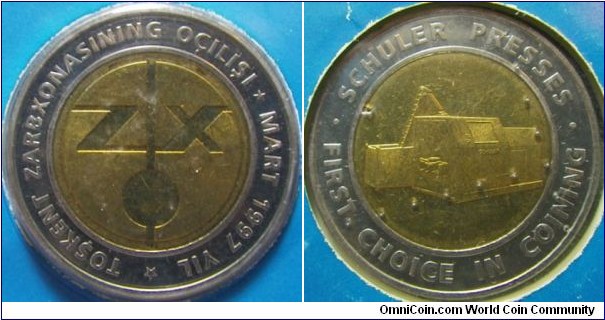
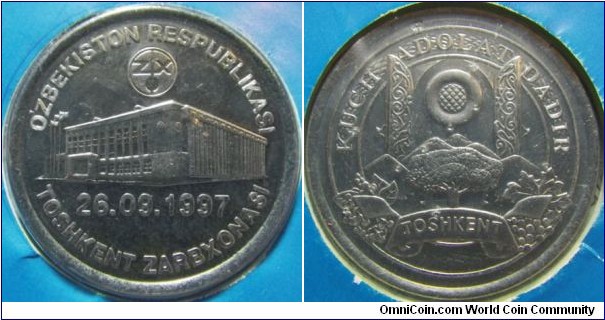
As you can see the tokens, it seems that they refer to the year "1992". I suspect that this would be the year when the mint was first open. As of what the dates mean on the two tokens, I have no idea. Probably the date of when the tokens were struck or one of them might refer to the opening of the mint.
Now this is something that I had to queston - I don't think I've ever seen bi-metal coins / tokens from Uzbekistan and this is the first. Uzbekistan has been striking coins from 1997 to 2002 and then in 2004, 2009 and 2011. I just can't help to think that there has been a possibility to strike commemorative coins in bi-metal but didn't.
Nevertheless - something interesting that I've picked up I guess.
-
Doesn't look genuine to me. If it's magnetic, it's definitely not genuine.
-
This is a really difficult set to assemble. A few coins were from ex-mint sets and took a lot of patience to gather this set. I don't think I'll upgrade a couple of the coins as the asking price for some of them are just absurd. The last coin that I needed was the 1975 50 kopek.
Key dates of this are as follows: 1970 - 1972, 1975 is a surprise. All these four coins look like they were from ex-mint sets. 1979 and 1980 both look like they were from mint sets as well.
Another big surprise is the 1991 50 kopek struck in Moscow mint - this was quite difficult to find despite low catalog value.
Enjoy the picture that I've put together.
http://www.gxseries.com/numis/rus_new_type/russia_50k_61_pg1_small.jpgMaybe you would like to attempt a simliar set like this? Please feel free to show your 50 kopek collection.
-
Sad to hear such legend passing away and at the same time not really knowing who he is.
If his collection is so huge, what didn't he not have other than some extremely rare pattern coins? Probably might have some uncataloged variety coins. Very impressive to see the copper plate.
-
Picked up this interesting coin from Ireland that's dated 1690. Not the best condition out there but it didn't burn a hole in my pocket. Plus the details stand out a fair bit.
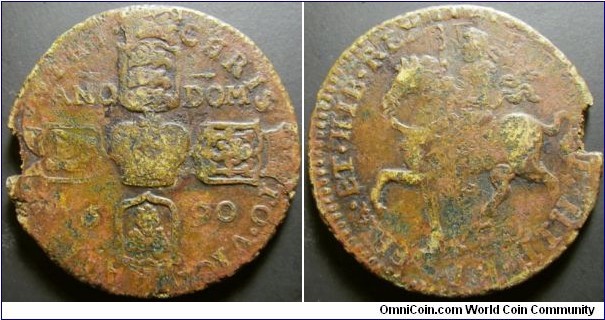
As I collect overstruck coins, this is one of those must haves as it tells an interesting history. Despite this type of coin is labelled as gun money, church bells were used as well.
This was struck during James II era during 1689 - 1691. As England was waging a war, coins were struck in base metals. The original coins struck in 1689 had months dated on them as well as these coins were supposed to be gradually redeemable to silver except this didn't happen - James II lost the war.
Inflation must have occured as coins were overstruck with twice the face value, i.e. crowns overstruck using half crown coins, shillings over sixpence and so forth.
More information on wikipedia http://en.wikipedia.org/wiki/Gun_money
-
Would be nice to obtain a nice example like shown but I'm sure it will cost a fair amount. Nevertheless, happy with what I have.
 Remember buying the first coin while I was a student back then.
Remember buying the first coin while I was a student back then. -
Won this recently as the poltina that I had in my collection didn't look too great.
This was what I had.
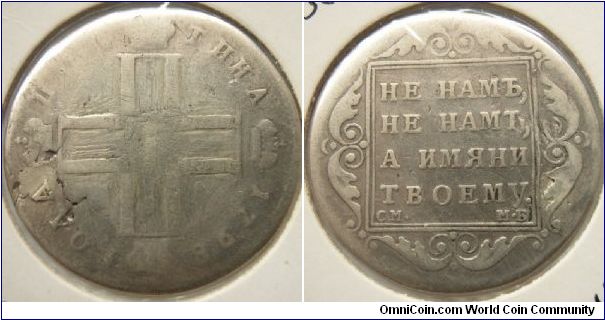
As you can tell, the side with Paul I's monogram was engraved to show more details.
And this is the one that I recently won.
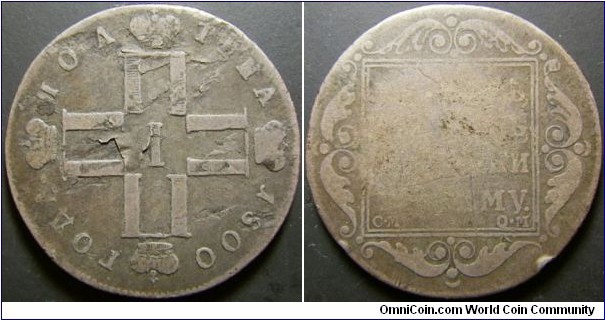
Nice lamination but the obverse text is pretty much worn out.
To be honest, I'm quite torn - you have two coins with one good side. It's still a rather uncommon coin that pops up once in a while. I guess you can't always win them all.
C'est la vie.



Edge Type on 1796 EM 10 Kopecks
in Russian Coin Forums
Posted
It's a ridiciously impressive coin. Can't say much about the authencity but it's awesome! Congradulations! Now I'm the one that's drooling.